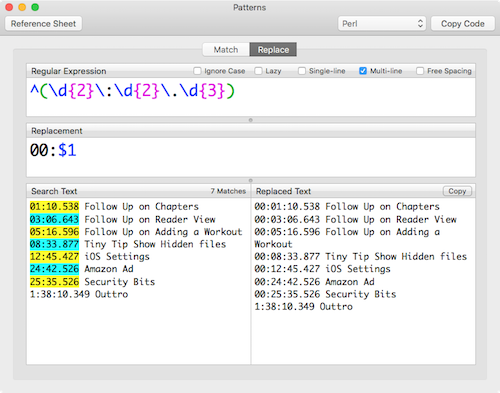- Patterns Regex Mac App Download
- Patterns Regex Mac App Shortcut
- Patterns Regex Mac App Tutorial
- Patterns Regex Mac App Shortcuts
- Regex Pattern Java
When you want to search and replace specific patterns of text, use regular expressions. They can help you in pattern matching, parsing, filtering of results, and so on. Once you learn the regex syntax, you can use it for almost any language.
All Regex pattern identification methods include both static and instance overloads. The regular expression engine must compile a particular pattern before the pattern can be used. Because Regex objects are immutable, this is a one-time procedure that occurs when a Regex class constructor or a static method is called. A powerful tool for searching and replacing text, regular expressions (often referred to as regex) can be intimidating—unless you’ve got BBEdit.The app’s Pattern Playground feature makes this arcane syntax more accessible to developers and writers alike.
Press Ctrl+R to open the search and replace pane.
If you need to search and replace in more than one file, press Ctrl+Shift+R. For more detailed information, refer to Search and replace a target within a project.
Enter a search string in the top field and a replace string in the bottom field.
Click to enable regular expressions. If you want to check the synax of regular expressions, hover over and click the Show expressions help link.
When you search for a text string that contains special regex symbols, IntelliJ IDEA automatically escapes them with backlash
in the search field.Keep in mind that if you copy (Ctrl+C) the string first and then paste (Ctrl+V) it in the search field, the regex symbols will not be taken into account.
However, when you specifically search for metacharacters such as
.[{()^$|?*+, you need to escape them with backslash, so they can be recognized.For example, if you need to find
., type.in the search field.IntelliJ IDEA can also match a letter case when you enter a range of characters in your search field.
For example, if you want to search for only uppercase characters, type the following in the search field:
To search and replace more complicated patterns, use the structural search and replace.
If is unselected in the search field, IntelliJ IDEA searches for both lower and upper cases.
Select in the search field to match the case of the specified range.
When you browse the occurrences, IntelliJ IDEA displays the replacement hints, so you can view the potential results before clicking the Replace button.

See RegEx syntax for more details.
Use regex capturing groups and backreferences
Patterns Regex Mac App Download
You can put the regular expressions inside brackets in order to group them. Each group has a number starting with 1, so you can refer to (backreference) them in your replace pattern. Note that the group 0 refers to the entire regular expression. However, you can refer to the captured group not only by a number $n, but also by a name ${name}.
For example, for the numbered capturing groups, use the following syntax:
For the named capturing groups, use the following syntax:
Find and replace a captured group
Let's consider the following code:
Open the search and replace pane Ctrl+R.
In the search field, enter parentheses
()that would indicate a capturing group, for example:stitle='(.*)?'s*(/>*).In the replace field, backreference such groups by numbers starting with 1, for example:
IntelliJ IDEA highlights the found occurrences based on your search specifications and displays hints with the replace string.

Patterns Regex Mac App Shortcut

Patterns Regex Mac App Tutorial
Switch the character case
You can use regular expressions to change the case of characters that matches some criteria.
Patterns Regex Mac App Shortcuts
Open the search and replace pane Ctrl+R. Make sure that is selected in the search field.
In the search field enter the search pattern.
In the replace field, depending on what you want to achieve, enter one of the following syntax:
lchanges a character to lowercase until the next character in the string.
For example,Barbecomesbar.uchanges a character to uppercase until the next character in the string.
For example,barbecomesBar.Lchanges characters to lowercase until the end of the literal stringE.
For example,BARbecomesbar.Uchanges characters to uppercase until the end of the literal stringE.
For example,barbecomesBAR.
Refer to the RegEx syntax reference table for more details.